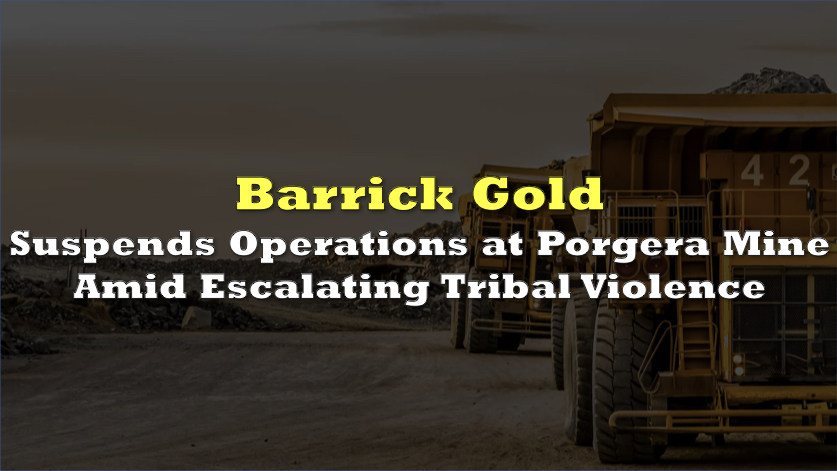An internal report has revealed that a subsidiary of Barrick Gold (TSX: ABX), operating in Tanzania, incurred annual losses of up to $31 million due to organized criminal activities, some of which involved local law enforcement. The report, obtained by The Globe and Mail, sheds light on troubling issues at the North Mara gold mine in Tanzania.
The investigation found that North Mara was deeply penetrated by at least one criminal syndicate, which orchestrated thefts of millions of dollars in fuel, equipment, and high-grade gold-bearing rock, often with the cooperation of local police. Additionally, the report highlighted a widespread presence of corruption, fraud, and misappropriation within the mine’s contracts and land compensation payments.
This internal report has come to light in connection with an ongoing case in the High Court of Justice in London. Tanzanian villagers are alleging that Barrick cooperated with local police who caused harm and injuries within the community, a claim vehemently denied by the company.
Conducted in November 2017, the 21-page report was prepared by Europe Conflict and Security Consulting Ltd., a consulting firm, for a security contractor at Acacia Mining, a British-based subsidiary of Barrick that was responsible for operating gold mines in Tanzania at the time.
The report estimated that the criminal activities at North Mara could exceed $20 million annually, potentially reaching up to $31 million. Shockingly, it revealed that both Acacia staff and the criminal syndicate were implicated in the various criminal activities, indicating a significant level of collusion and infiltration.
Barrick has faced long-standing scrutiny for over a decade regarding police-related violence and fatalities at North Mara. Numerous local villagers have reportedly suffered injuries or lost their lives at the hands of police officers who receive regular support from the company for providing security at the mine. In 2019, Barrick assumed direct control of the mines after acquiring full ownership of Acacia, which had previously been 64% owned by Barrick.
The company has often attributed the violence to “intruders,” referring to villagers who illegally entered the mine in search of gold-bearing rock.
However, the internal report contradicted this assertion, estimating that the losses resulting from trespassers amounted to only about $200,000 annually.
In stark contrast, the report pointed out that the mine was losing as much as $2.5 million annually due to the organized theft of high-grade gold-bearing material from heavily secured sections of the mine, involving both Acacia’s staff and the police. Astonishingly, as much as 250 kilograms of high-grade gold-bearing material was being stolen every day.
The criminal syndicates at North Mara demonstrated remarkable intelligence, operational capability, and organizational prowess. They possessed the means to manipulate security cameras, move stolen items undetected, swiftly alter escape routes when detected, and even enlist the support of the police and security personnel.
The report also suggested that as many as 30% of the mine’s staff could be implicated in these activities, with local government and political patronage providing protection to the criminals. Apart from the direct theft of materials, corruption in land compensation agreements was estimated to result in additional annual losses ranging from $10 million to $29 million, with further undisclosed costs arising from contract fraud and unauthorized gold mining around the mine.
Despite these concerning findings, Barrick’s annual reports since 2017 have not disclosed the presence of organized criminal groups at North Mara or their collusion with the police. It remains unclear whether such losses have persisted at the same scale in recent years.
However, in March of the current year, Barrick announced that a Tanzanian government task force investigating gold smuggling had requested access to inspect an underground area at the North Mara mine. The task force’s operation led to the discovery of an illegal miner who tragically fell to his death while attempting to evade arrest.
In the ongoing London court case, Barrick acknowledged that it was aware of allegations of criminal syndicate infiltration at the mine, along with police collusion. The company claimed to have taken measures to prevent collusion, including the rotation of police officers assigned to the mine site. Barrick also asserted that it had reported suspected police officers to the regional police commissioner for allowing trespassers into the North Mara site.
In response to these allegations, lawyers for the Tanzanian claimants argued that Barrick must disclose more information regarding the criminal activities at North Mara. They contended that police violence was sometimes a direct result of collusion between the police and one or more criminal syndicates at the mine. Police allegedly controlled access to the site, using force against villagers suspected of competing with the syndicates for gold-bearing rock.
Rights and Accountability in Development (RAID), a British-based rights group, expressed deep concern over the alleged police involvement in organized criminal syndicates at North Mara, especially considering the ongoing security role of the police at the mine. Anneke Van Woudenberg, executive director of RAID, questioned Barrick’s close relationship with the police, suggesting that the company should be reducing its reliance on law enforcement rather than increasing it.
Barrick, in its previous responses regarding police violence, consistently argued that it neither employs nor controls the Tanzanian police, although it acknowledged a signed agreement with the police and its provision of support to them.
Information for this briefing was found via The Globe And Mail and the sources mentioned. The author has no securities or affiliations related to this organization. Not a recommendation to buy or sell. Always do additional research and consult a professional before purchasing a security. The author holds no licenses.











